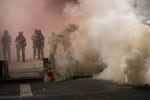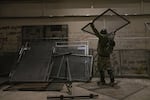Oregon Gov. Kate Brown’s office is in serious talks with the Trump administration to remove the surge of federal officers from Portland, according to people familiar with the discussions.
Related: Deal reached: Federal officers to begin leaving Portland Thursday
While precise details of any potential agreement remain murky, one law enforcement source on Tuesday described a scenario where the additional federal officers sent to Portland by President Trump weeks ago would be removed from the city, in exchange for state law enforcement taking up the task of protecting Portland’s federal courthouse from vandalism.

Federal officers deploy gas to disperse crowds of protesters near the Mark O. Hatfield federal courthouse in Portland, Ore., July 20, 2020.
Jonathan Levinson / OPB
“The idea is it gets BORTAC out of Portland and to return to the pre-surge federal law enforcement levels there,” the source said, referring to a Customs and Border Protection tactical unit. The law enforcement official requested anonymity because they were not authorized to speak on the record about the negotiations.
While Brown’s office declined to discuss the particulars of the conversations, the governor’s chief of staff, Nik Blosser, said Tuesday evening that talks began in earnest Monday. Sources told OPB that’s the same day two high-ranking federal officials were in Portland, meeting with people in state government. The goal is to reach a deal before the weekend when crowds could grow again, according to a law enforcement source.
Early Wednesday, President Trump told reporters that federal agents would not leave Portland until the mayor and governor have “secured their city” from protesters.
The developments suggest there could be an end in sight in the prolonged standoff between the federal government and Oregon officials, which began earlier this month and led to large nightly protests along a metal fence surrounding the Mark O. Hatfield Courthouse in downtown Portland.
Last week, court documents stated at least 114 federal officers from DHS, the U.S. Marshals Service and other federal agencies had been guarding the facility against demonstrations that have at times included vandalism and fireworks. The enhanced law enforcement presence has become a rallying point for protesters and elected officials who have demanded they leave town. The Trump administration has repeatedly refused, saying it has a duty to protect federal property during demonstrations that have continued for more than two months.
The Associated Press first reported Tuesday that the administration had begun talks with Brown, describing bargaining as being in the early stages. Blosser, though, described “very serious conversations with the administration.” He declined to provide further details on those talks, or discuss potential outcomes.
Multiple people told OPB that two senior officials traveled to Portland this week: FBI deputy director David Bowdich and Rudolph “Tex” Alles, the undersecretary of management at DHS. Bowdich returned to Washington, D.C., on Tuesday to brief U.S. Attorney General Bill Barr and FBI Director Christopher Wray, according to a source with knowledge of the situation.
Oregon U.S. Attorney Billy Williams declined to comment on discussions Tuesday. The Department of Homeland Security also declined to comment.
The talks between administration officials and Brown’s office come as the federal presence in Portland continues to draw national attention. On Tuesday, in an appearance before a Congressional committee, Barr mounted a fierce defense of the deployment to Portland.
“We are on the defense. We’re not out looking for trouble,” Barr said, describing instances of federal officers being injured by thrown objects and large fireworks thrown by what he termed a “mob.” He said officers were sent to Portland to defend federal property.

A protester stacks pieces of fence in front of the Mark O. Hatfield federal courthouse on July 18, 2020. The federal police presence has galvanized protesters, bringing out a larger group than on recent nights.
Jonathan Levinson / OPB
Face-to-face meetings and a potential deal to reduce federal presence in Portland represent a notable shift for local officials. Portland Mayor Ted Wheeler said he would have declined meeting with acting DHS Secretary Chad Wolf during a July 16 visit to Portland. And until this week, state and federal lawmakers from Oregon had largely restricted their conversations to sharply worded letters and barbs via social media. President Trump has responded in kind by blasting local leaders on Twitter.
Federal officers arrived in Portland in early July. At the time, the number of protesters had dwindled as low as 100 people. But federal officers have made several high profile missteps, escalating tensions with demonstrators.
Since deploying to Portland, U.S. Marshals shot Donavan La Bella, 26, in the head with a crowd control weapon. Federal officers also faced sharp criticism for beating Navy veteran Christopher David, who had not threatened officers in any way. David required surgery to repair a broken hand and La Bella was hospitalized for two weeks with a skull fracture. Countless others have been injured by impact munitions used on a nightly basis.
Officers with CBP’s BORTAC unit pulled protester Mark Pettibone into an unmarked vehicle without explanation, his hat pulled over his eyes. That incident, first reported by OPB, drew national attention to escalating actions by federal officers in Portland.
The series of missteps have contributed to large turnouts among protesters, federal officials have acknowledged to OPB. Many protesters also now attend demonstrations wearing gas masks and helmets, with some carrying shields, umbrellas and leaf blowers to counteract law enforcement crowd control efforts.
Many of the federal officers deployed to Portland are not trained in crowd management, potentially making a handoff to local law enforcement more appealing. Some have also been injured during encounters with protesters.
Barr’s comments Tuesday underscored a consistent message the Trump administration has offered about the situation in Portland: That it is not willing to leave the federal courthouse and a nearby federal office building unprotected.
“It is not a solution to tell federal officers to leave when there continues to be attacks on federal property and personnel,” Williams, the U.S. attorney in Oregon, said during a press briefing this week. “We’re not leaving the building unprotected to be destroyed by people intent on doing so.”
Administration officials have repeatedly accused Portland police of failing to intervene in vandalism at the building, and President Trump has said protesters want to burn the structure down. At the same time, Wheeler, who serves as both mayor and the city’s police commissioner, has offered no suggestion the local police would be willing to take a role in guarding the courthouse.
That potentially leaves such a duty to the governor, who sent both National Guard troops and Oregon state troopers to assist Portland police in June, when demonstrations over police violence were just beginning.
Any deal for removing federal officers from Portland would be notable, given where the situation stood over the weekend. As OPB first reported, several dozen additional law enforcement officers were deploying, or had deployed, to Portland.